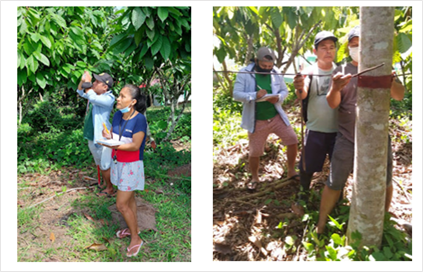Screw (Cedrelinga catenaeformis) and Marupa (Simarouba amara) growth within a multistrata agroforestry system
DOI:
https://doi.org/10.56926/repia.v1i1.10Keywords:
tropical forests, floral diversity, reforestation, water regulationAbstract
In the installation of agroforestry systems in multistrata it is important to know the behavior of the species that make up the system. The objective was to evaluate the growth in height (m) and trunk diameter (cm) of Cedrelinga catenaeformis and Simarouba amara as cocoa shade trees in a multi-strata agroforestry system. We established the system in a soil with a sandy loam texture, with organic matter of 1.26%. We installed the forest components at a distance of 12 x 12 m for screw, 6 x 6 m for marupa and 3 x 3 m for cacao. We associated it with Cajanus cajan the first year and we established it as a cover for Centrosema macracarpum. The forest components in the sixth year reach a height of 13.00 and 12.82 m, respectively, and a trunk diameter of 13.22 and 18.33 cm. We concluded that the screw has an average height growth of 2.56 m and the marupa 2.52 m.
Downloads
References
Álvarez Gómez, L., & Ríos Torres, S. (2009). Evaluación económica de plantaciones de tornillo, Cedrilenga catenaeformis, en el departamento de Loreto (1st ed.). Instituto de Investigaciones de la Amazonía Peruana (IIAP).
Baluarte-Vásquez, J. R., & Alvarez-Gonzales, J. G. (2015). Modelamiento del crecimiento de Tornillo Cedrelinga catenaeformis Ducke en plantaciones en Jenaro Herrera, departamento de Loreto, Perú. Folia Amazónica, 24(1), 21. https://doi.org/10.24841/fa.v24i1.57
Bernal, R., Robbert Gradstein, M., Gradstein, S. R., Celis, M., Robbert Gradstein, S., Pacheco, M. C., & Orozco, C. I. (2016). Catálogo de plantas y líquenes de Colombia (Editorial Universidad Nacional de Colombia (ed.); 1st ed.). Instituto de Ciencias Naturales.
Carrión M., R., & Solano C., J. (2014). La industria maderera en el Perú. Industrial Data, 5(2), 74. https://doi.org/10.15381/idata.v5i2.6794
Castañeda-Garzón, S. L., Argüelles-Cárdenas, J. H., Zuluaga-Peláez, J. J., & Moreno-Barragán, J. (2021). Evaluación de la variabilidad fenotípica en Simarouba amara Aubl., mediante descriptores cualitativos y cuantitativos. Orinoquia, 25(1), 67–77. https://doi.org/10.22579/20112629.656
Claussi, A., Marmillod, D., & Blaser, J. (1992). Descripción Silvicultural de las plantaciones forestales de Jenaro Herrera (1st ed.). Instituto de Investigaciones de la Amazonia Peruana (IIAP).
De Rutté C., J., & Reynel R., C. (2016). Composición Y diversidad arbórea de un áreaen la cumbre del bosque montano nublado Puyu Sacha, Chanchamayo, Dp. Junín, Perú (1st ed.). Biblioteca Nacional del Perú.
Do Vale, I., Gonzaga Silva Costa, L., & Souza Miranda, I. (2014). Indicated species to restoration of riparian forests in subwatershed of Peixe-Boi river, Pará State. Ciencia Forestal Santa María, 24(3), 573–582. https://www.scielo.br/j/cflo/a/7LNFpB8LpR8RpqfFcbW6Dqk/abstract/?lang=en
Estoque, R. C., Ooba, M., Avitabile, V., Hijioka, Y., DasGupta, R., Togawa, T., & Murayama, Y. (2019). The future of Southeast Asia’s forests. Nature Communications, 10(1), 1829. https://doi.org/10.1038/s41467-019-09646-4
Flores-Vinda, E., & Obando-Vargas, G. (2003). Árboles del Trópico Húmedo (1st ed.). Editorial Tecnológica de Costa Rica.
Guariguata, M. R., Arce, J., Ammour, T., & Capella, J. L. (2017). Las plantaciones forestales en Perú: Reflexiones, estatus actual y perspectivas a futuro. In Documento Ocasional 169 (pp. 1–40). (CIFOR). https://doi.org/10.17528/cifor/006461
López C., R. (2010). Estudio Silvicultural del Tornillo (Cedrelinga catenaeformis Ducke). Revista Forestal Del Perú, 10(1–2), 1–7. http://cedinfor.lamolina.edu.pe/Articulos_RFP/Vol10_no1-2_80-81_(14)/vol10_art10.pdf
López Camacho, R., & Cárdenas López, D. (2002). Manual de identificación de especies maderables objeto de comercio en la Amazonia colombiana (1st ed.). Instituto Amazónico de Investigaciones Científicas “SINCHI.”
Nuñez Pérez, H. (2018). Crecimiento de plántulas de Cedrelinga cateniformis “tornillo”, en vivero Puero Almendras-Loreto, Perú [Universidad Nacional de la Amazonía Peruana]. http://repositorio.unapiquitos.edu.pe/handle/20.500.12737/6924
Rozendaal, D. M. A., Poorter, L., Van der Sande, M. T., Thompson, J., Arets, E. J. M. M., Alarcón, A., Álvarez-Sánchez, J., Ascarrunz, N., Balvanera, P., Barajas-Guzmán, G., Boit, A., Bongers, F., Carvalho, F. A., Casanoves, F., Cornejo-Tenorio, G., Costa, F. R. C., de Castilho, C. V., Duivenvoorden, J. F., Dutrieux, L. P., … Peña-Claros, M. (2015). Diversity enhances carbon storage in tropical forests. Global Ecology and Biogeography, 24(11), 1314–1328. https://doi.org/10.1111/geb.12364
Sierra Praeli, Y. (2021, October 7). Perú alcanza cifra de deforestación más alta en los últimos 20 años. MONGABAY. https://es.mongabay.com/2021/10/peru-aumenta-deforestacion-cifras-bosques/
Smith, J., & Schwartz, J. (2015). La deforestación en el Perú (pp. 1–6). Fondo Mundial para la Naturaleza. https://www.academia.edu/download/41277041/la_deforestacion_en_el_peru.pdf
Ugarte-Guerra, J., & Román-Dañobeytia, F. (2020). Tasas de crecimiento de cuatro especies nativas en plantaciones forestales comerciales en cuatro regiones de la Amazonía Peruana. Revista Forestal Del Perú, 35(3), 44. https://doi.org/10.21704/rfp.v35i3.1600
Vidaurre Arévalo, H. E. (1994). Balance de experiencias silviculturales con Cedrelinga catenaeformis Ducke (Mimosoideae) en la Región de Pucallpa, Amazonía Peruana [Centro Agronómico Tropical de Investigación y Enseñanza]. https://repositorio.catie.ac.cr/handle/11554/4534

Published
How to Cite
Issue
Section
License
Copyright (c) 2022 Beto Pashanasi-Amasifuen, Analy Nohely Aponte-Jaramillo , Marco Antonio Mathios-Flores

This work is licensed under a Creative Commons Attribution 4.0 International License.
Authors retain their rights:
a. The authors retain the intellectual property rights (copyright) of the published works, assigning to the journal the right of first publication.
b. Authors retain their trademark and patent rights, and also on any process or procedure described in the article.
c. Authors retain the right to share, copy, distribute, perform and publicly communicate the article published in REPIA (e.g., place it in an institutional repository or publish it in a book), with an acknowledgement of its initial publication in REPIA.
d. Authors retain the right to make a subsequent publication of their work, to use the article or any part of it (e.g., a compilation of their work, notes for conferences, theses, or for a book), provided they indicate the source of publication (authors of the work, journal, volume, number, and date).







